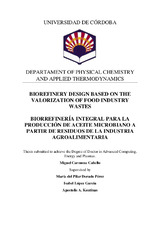Mostrar el registro sencillo del ítem
Biorefinery design based on the valorization of food industry wastes
| dc.contributor.advisor | Dorado, M.P. | |
| dc.contributor.advisor | López García, Isabel | |
| dc.contributor.advisor | Koutinas, Apostolis A. | |
| dc.contributor.author | Carmona Cabello, Miguel | |
| dc.date.accessioned | 2020-01-29T11:24:00Z | |
| dc.date.available | 2020-01-29T11:24:00Z | |
| dc.date.issued | 2020 | |
| dc.identifier.uri | http://hdl.handle.net/10396/19408 | |
| dc.description.abstract | The current environmental predicament requires the search for renewable and sustainable alternatives to fossil fuels, mainly in the transport sector. Biodiesel may replace diesel fuel using an environmentally friendly and economically efficient process, as long as the raw material employed is low-cost and derived from sustainable sources. Such an alternative feedstock from non-vegetable sources, does not compete with food market or land use sources. Annually, around 1.3 billion tons of food are discarded or wasted. This huge quantity has led researchers to search for new applications for this carbon source. Waste management is one of the most significant challenges of EU policies for the coming decades. Our changing food habits carry an inherent increase in waste nutrients, that are definitely worth recycling. The traditional method of waste management is not adapted to meet future energy and environmental requirements. A food waste-based biorefinery allows new approaches in waste recovery, while improving industrial processes. This PhD thesis is based on a biorefinery concept and takes advantage of each nutrient that composes food waste. Food waste (FW) composition from local catering services was analyzed. The analysis showed a high moisture content, the main components were lipids (25.7-33.2, w/w), starch (16.2-29.4%, w/w) and proteins (18.3- 23.5%, w/w) on a dry basis. Also, a metal profile with Na and Mg as main components was found, followed by trace elements, e.g. Zn or Fe. The variability of samples was studied using various statistical tests, and its relationship with FW typology was elucidated. The combination of both, chemical characterization and statistical study, is revealed as a good decision-making tool for further FW processing and valorization. According to initial characterization analysis, oil included in solid food waste (SFW) was found to be feasible for use to produce biodiesel that meets European biodiesel standard EN 14214. For this purpose, Soxhlet extraction of the lipid fraction of SFW from different restaurants was carried out. Fatty acid composition was analyzed and potential differences concerning the source of SFW were evaluated through principal component analysis. Results showed that fatty acid composition of oils from SFW differs depending on the restaurant, but the range of fatty acid methyl esters (FAME) is similar to that found in vegetable oils, showing a high content of oleic acid (C18:1) and linolenic acid (C18:2). Due to high free fatty acid content, acid esterification pre-treatment was conducted, followed by a basic transesterification optimization, by both conventional and ultrasound (US) assisted reactions. Response surface methodology was selected to perform the experimental design; optimal conditions for conventional transesterification resulted in 93.23% w/w fatty acid methyl esters (FAME) conversion. Several chemical and physical properties of SFW oil biodiesel were analyzed. It was found that biodiesel fulfils the European standard EN 14214, with the exception of FAME yield, oxidation stability and glyceride content. It may be concluded, from this field trial, that oil from SFW from different restaurants may be mixed together and used to produce biodiesel. Finally, oleaginous yeasts were evaluated via hospitality food waste fermentation. In light of the starch and protein content of food waste, controlled enzymatic hydrolysis was considered feasible, and required enzymes may be provided through solid state fermentation (SSF) using A. awamori and potato peel as substrate. Crude hydrolysates were subsequently used in shake flask fermentations, with oleaginous yeast Rhodosporidium toruloides Y-27012, attaining a total dry weight (TDW) of 32.9 g/L and a lipid content within the cells of 36.4 %. Results of R. toruloides fermentations in a fedbath bioreactor showed a TDW of 53.9 g/L and a lipid production of 26.7g/L. Moreover, fatty acid profile of microbial oil from bioreactor samples revealed the presence of palmitoleic acid (C16:0) and oleic acid (C18:1) as main components. The principal component analysis (PCA) performed showed a fatty acid profile similar to soybean or solid food waste oil (SFWO). Finally, recovered microbial oil was transesterified to biodiesel, achieving a yield of 94%, which almost fulfills the European standard normative EN 14212. | es_ES |
| dc.format.mimetype | application/pdf | es_ES |
| dc.language.iso | eng | es_ES |
| dc.publisher | Universidad de Córdoba, UCOPress | es_ES |
| dc.rights | https://creativecommons.org/licenses/by-nc-nd/4.0/ | es_ES |
| dc.subject | Waste management | es_ES |
| dc.subject | Biorefinery | es_ES |
| dc.subject | Biodiesel | es_ES |
| dc.subject | Microbial oil | es_ES |
| dc.subject | Transesterification | es_ES |
| dc.subject | Circular economy | es_ES |
| dc.title | Biorefinery design based on the valorization of food industry wastes | es_ES |
| dc.title.alternative | Biorrefinería integral para la producción de aceite microbiano a partir de residuos de la industria agroalimentaria | es_ES |
| dc.type | info:eu-repo/semantics/doctoralThesis | es_ES |
| dc.rights.accessRights | info:eu-repo/semantics/openAccess | es_ES |

